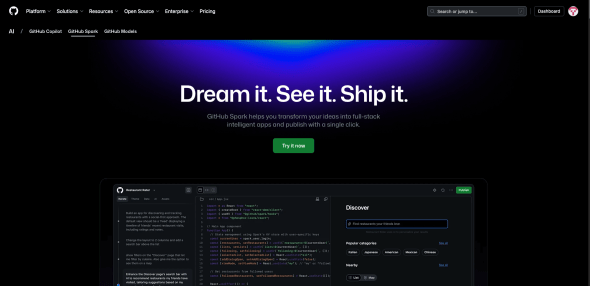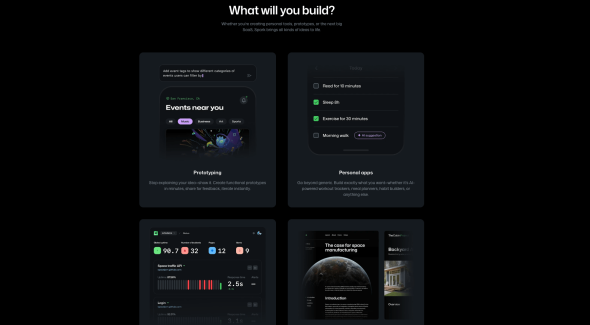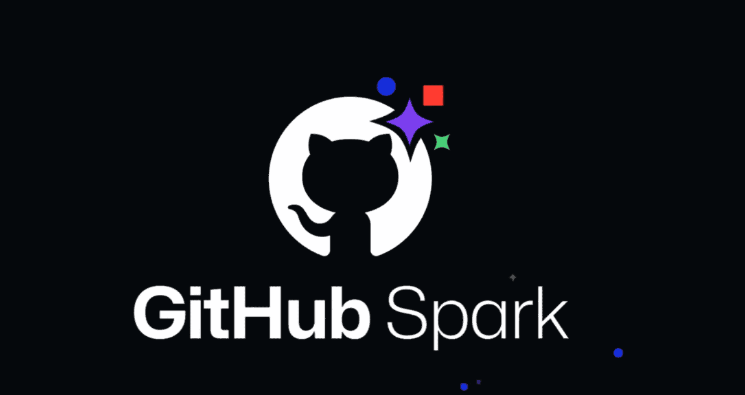GitHub Spark: An Idea to a Deployed App in Just Minutes
GitHub Spark is an ai application generator that builds and deploys full-stack web applications from natural language prompts. Developed by GitHub, a Microsoft subsidiary, the tool was launched as a public preview on July 24, 2025. It is an extension of the GitHub Copilot family, integrated into the Copilot Pro+ subscription plan.
GitHub Spark is useful because it shortens the development process, turning an idea into a functional, live application in minutes instead of months. It targets a wide audience, from experienced developers seeking to automate boilerplate tasks to non-coders, product managers, and entrepreneurs who want to build prototypes without writing code. The platform’s main value is its ability to make software creation more accessible. It alters traditional development workflows by handling everything from code generation and setup to hosting and deployment, allowing users to focus on their application’s features and functionality.
Best Use Cases for GitHub Spark
- Startup Founders and Product Managers: For those needing to validate a business idea, GitHub Spark is an effective prototype builder. It allows you to construct a minimum viable product (MVP) from a simple description. This helps you gather real user feedback and iterate on features without dedicating months to initial development, reducing the time and cost required to test market fit.
- Developers and Engineering Teams: When a team needs a custom internal tool, like a data visualization dashboard or an admin panel, they can use this ai web app builder to generate a functional baseline. This frees up engineering resources to focus on more complex, core business problems, while still delivering necessary internal utilities with speed.
- Students and Aspiring Coders: For individuals learning to code, GitHub Spark provides a practical educational experience. You can describe an application, see it get built, and then study the generated React and TypeScript code. This offers a direct way to understand how a full-stack application is structured, connecting theory with real-world implementation.
- Designers and UI/UX Professionals: Designers can use the platform to bring static mockups to life. By describing the desired user interface and functionality, they can create interactive prototypes that behave like real applications. This is valuable for user testing and for communicating design concepts to stakeholders.
Fast Deployment: Go from a text prompt to a live web application in minutes, a process that traditionally takes much longer.
Direct GitHub Integration: Each GitHub Spark project is a standard repository, giving you immediate access to version control, GitHub Actions, and Dependabot.
Usable Without Coding Knowledge: The natural language interface lowers the barrier to entry for software development, allowing users without technical expertise to build their ideas.
Full Code Access: Unlike many no-code platforms, Spark provides the complete source code, allowing for deep customization by professional developers.
Managed Infrastructure: The platform includes hosting, data storage, and a design system, which removes the need for complex server setup.
Iterative AI Refinement: You can continue to modify your application by giving new instructions to the AI, making the revision process quick and direct.
Limited Tech Stack: Currently, this ai application generator is restricted to creating apps with React and TypeScript.
Slower Generation at Times: The process, while thorough, can sometimes take longer than tools focused only on front-end generation.
No Custom Domain Support: Deployed applications are hosted on a GitHub-provided URL, with no current option for a custom domain.
Potential for Code Bugs: The AI-generated output can sometimes contain errors or non-optimal code that requires manual correction.
Unpredictable AI Interpretation: For complex requests, it can be difficult to foresee how the AI will interpret the prompt, sometimes leading to unexpected results.
-
Natural Language Application Generation: The core function that interprets English prompts to build full-stack applications.
-
Integrated Web IDE: A built-in code editor that allows you to view and modify the generated code in your browser.
-
Live Application Preview: See real-time updates to your application as you make changes.
-
Managed Runtime Environment: A backend that includes hosting, a persistent database, and a themable design system.
-
Multi-Model Support: Uses Anthropic’s Claude Sonnet 4 by default but allows switching to other models like GPT-4o and Gemini 1.5 Pro.
-
One-Click Deployment: Publish your application to a public URL with a single button.
-
Automatic GitHub Repository Creation: Every GitHub Spark project is automatically set up as a GitHub repo.
-
AI-Assisted Refinements: Use chat to add new features, change the UI, or modify application behavior after its initial creation.
-
Version History: A visual timeline lets you see all changes and revert to previous versions.
 GitHub Spark Homepage
GitHub Spark Homepage
 Application Gallery
Application Gallery
Frequently Asked Questions
-
What is GitHub Spark?
GitHub Spark is an ai web app builder that creates applications based on text descriptions. -
Who can use GitHub Spark?
GitHub Spark is available to users with a GitHub Copilot Pro+ subscription. -
What programming languages does GitHub Spark use?
The tool currently generates applications using React and TypeScript. -
Can I edit the code generated by GitHub Spark?
Yes, users have full access to the source code and can edit it directly. -
Does GitHub Spark handle hosting?
Yes, GitHub Spark provides a managed runtime environment that includes hosting and a database. -
How to generate an AI application?
Users generate an application in GitHub Spark by writing a text prompt that describes the app’s functionality.
Tech Pilot’s Verdict on GitHub Spark
I have tested many AI development tools, and GitHub Spark stands out. My goal was to determine if this platform could convert a simple idea into a working app without the usual setup and coding friction.
For my first test, I gave the platform a direct prompt: “Create a web app for tracking daily reading habits. It needs a form to add a book title, author, and pages read. Display the entries in a list.” I wanted to see how it would handle the data, UI, and state. In about three minutes, it generated a working application. The UI was clean, and the form correctly added new entries to a list on the page. It created the React components, handled data persistence, and deployed it to a live URL. The process was efficient.
Next, I pushed it further, asking it to “add a feature to calculate the total pages read this week.” Its ability to iterate was clear. This AI agent understood the request, modified the code, and updated the UI. However, the generated code for the calculation was not perfectly optimized. It worked, but a developer might have written it differently. This shows what GitHub Spark is: a strong accelerator. For production-level applications, a developer should review and refine the code.
Top Alternatives to GitHub Spark
-
Emergent: Emergent uses multiple AI agents to build applications. It is designed to be more autonomous than GitHub Spark, creating full-stack apps with complex backends. Emergent AI may be better for users who want a hands-off process for building complicated systems, but it does not have the same level of integration with GitHub’s tools. Emergent is a good choice for non-technical founders, whereas GitHub Spark is better for those who want an assistant within a familiar development workflow.
-
Cursor: Cursor is an AI-native code editor, not an application generator. It improves the coding experience by integrating AI directly into the IDE. Cursor is for developers who want to write code faster. It does not build the whole app for you like GitHub Spark does. Choose Cursor if you are a hands-on developer; choose GitHub Spark if you want to generate the application foundation first.
-
Lovable: Lovable is an ai web app builder that is good at generating front-end UIs and marketing websites. Its strength is its speed for simpler web presences. Lovable is a better choice for building a landing page quickly. However, GitHub Spark is more capable for creating data-driven applications with back-end logic, making it a more versatile tool for building software products.
Final Verdict
In summary, GitHub Spark is a very useful tool for prototyping and building internal applications. Its value at $39/month as part of the Copilot Pro+ plan is good, especially since it includes hosting. The learning curve is low for its basic features. While it won’t replace experienced developers for complex systems, it changes the starting point of development. It automates much of the preliminary work, allowing creators to focus on what makes their application unique.

